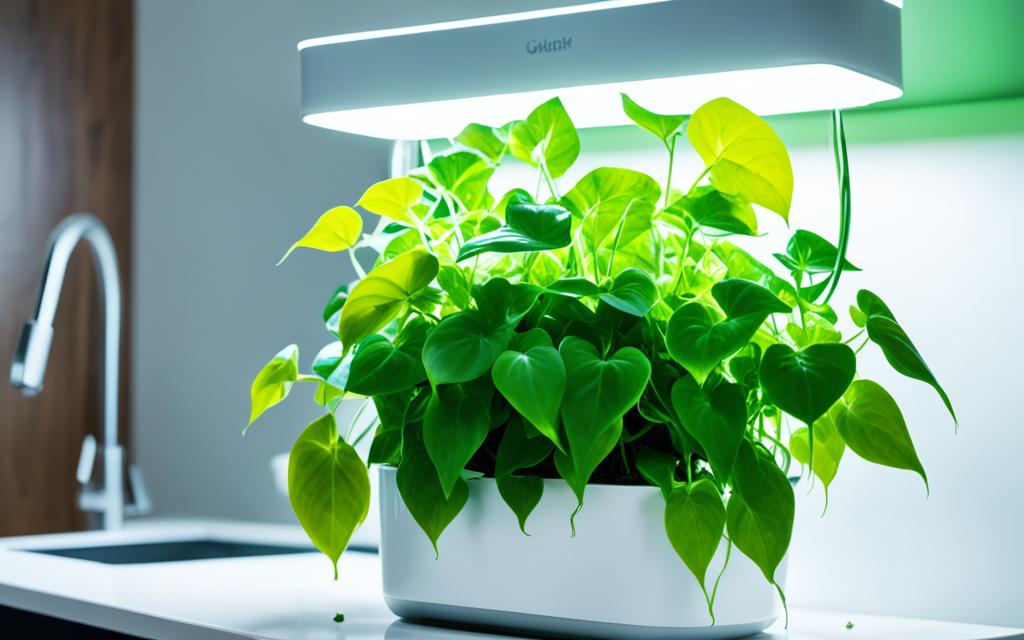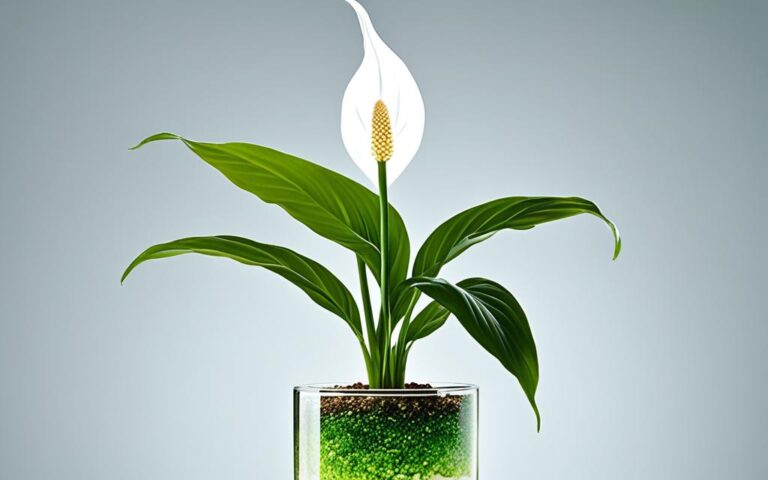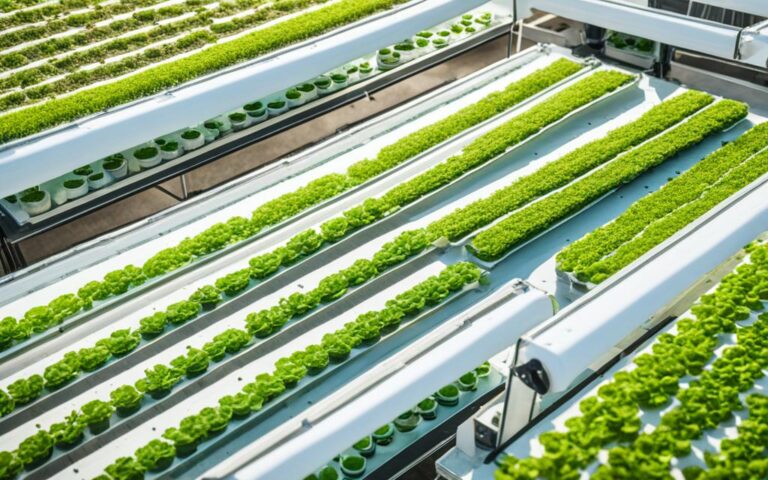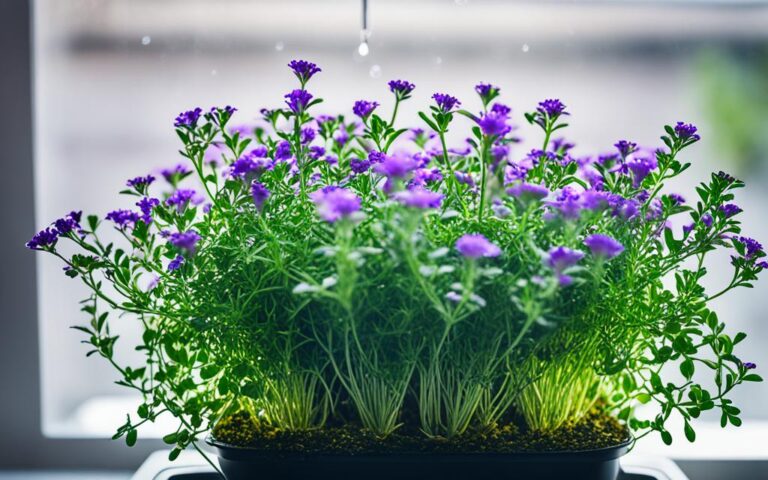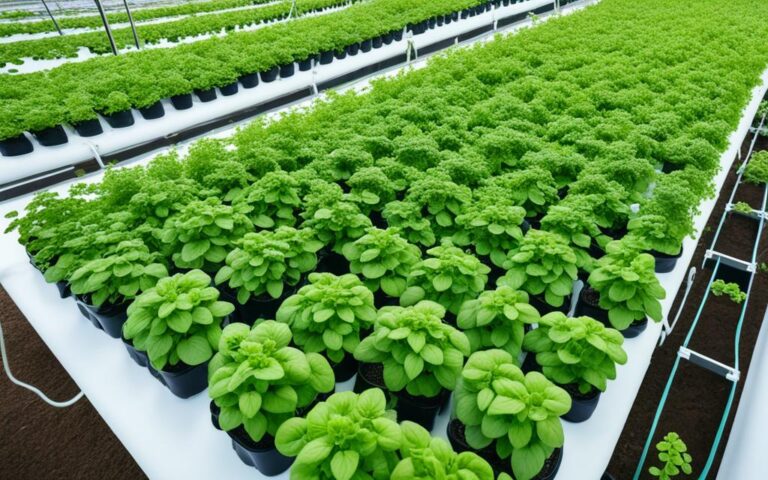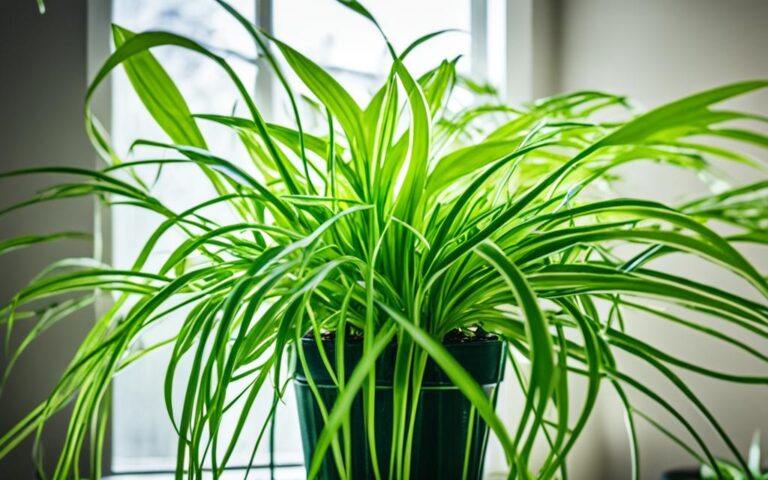Grow Hydroponic Devil’s Ivy – Easy Indoor Guide
Did you know a single plant can clean up to 60% of bad air in a room? This lively, air-cleaning houseplant is also known as the Golden Pothos or Epipremnum aureum. It’s easy to care for and can do well indoors with the right hydroponic setup. This guide will walk you through simple steps to help your plant flourish and spread, making your home a lush, green haven.
Key Takeaways
- Discover the benefits of growing as an indoor air purifier and luck bringer
- Learn how to easily propagate and maintain your plant
- Understand the ideal growing conditions, including temperature, lighting, and nutrient requirements
- Explore creative ways to display your in hanging baskets and vertical gardens
- Become a confident grower with our troubleshooting tips
Introduction to Hydroponic Devil’s Ivy
Explore the fascinating world of Devil’s Ivy, also known as Epipremnum aureum or Golden Pothos. This lively indoor plant loves low light and is a great air purifier. It’s perfect for making your home look beautiful and breathe cleaner air.
Devil’s Ivy: A Vibrant, Air-Purifying Houseplant
Devil’s Ivy is a quick-growing vine that can grow up to 4-6 meters tall outside. But indoors, it might not get that tall. Still, it’s a beautiful plant that brightens up any room. Its leaves are heart-shaped and come in various shades of green, adding a natural beauty to your space.
Varieties and Features of Devil’s Ivy
- “Aureum” – The classic variant with bright, golden-yellow hues in the center of the leaves.
- “Snow Queen” – Featuring stunning, variegated leaves with splashes of white and green.
- “Marble Queen” – Showcasing a marbled pattern of white, green, and yellow on the foliage.
Devil’s Ivy is a top pick for indoor plant lovers. It’s easy to care for and keeps the air clean, doing well in many light conditions.

“Devil’s Ivy is a true wonder of nature, with its vibrant foliage and the ability to purify the air we breathe. As an indoor houseplant, it brings a touch of the outdoors into our living spaces.”
Benefits of Growing Hydroponic Devil’s Ivy
Growing hydroponic Devil’s Ivy has many benefits for indoor gardeners. It’s easy to start and maintain, and it helps purify the air. Plus, it’s believed to bring good luck, making it a top choice for houseplants.
Easy Propagation and Maintenance
Devil’s Ivy is simple to propagate and care for. You can grow it from cuttings in water or soil. Once it’s up and running, it needs little attention. This makes it perfect for those who are busy or new to gardening.
Indoor Air Purifier and Luck Bringer
Devil’s Ivy is more than just pretty. It’s a top-notch air purifier, removing pollutants like formaldehyde and benzene. This Nasa-approved plant improves your indoor air quality. In some places, it’s seen as a lucky plant that brings prosperity.
| Benefits | Details |
|---|---|
| Easy to Propagate | Grow new plants from stem cuttings in water or soil |
| Low-Maintenance | Requires minimal care, making it ideal for busy homeowners |
| Indoor Air Purifier | Removes common household pollutants like formaldehyde and benzene |
| Lucky Plant | Considered a symbol of good fortune and prosperity in some cultures |
| Aquarium Cleaner | Can help keep aquariums clean by absorbing nitrates |
Devil’s Ivy is also great for aquariums. NASA says it’s an aquarium cleaner, absorbing nitrates to keep the water healthy.
“Devil’s Ivy is a true all-star in the world of houseplants, offering a wealth of benefits that make it an attractive choice for any indoor garden.”
Choosing the Right Hydroponic System
Choosing the right hydroponic system is key for growing hydroponic Devil’s Ivy. You’ll find many options, each with its own benefits and things to consider. Think about the size of your space, how much automation you want, and your budget.
The ebb and flow system is a top pick for hydroponic gardening. It floods the roots with nutrients at set times, helping plants absorb what they need. If space is tight, a vertical hydroponic system is great, making the most of your space.
Drip irrigation systems are good for those who don’t want to spend a lot of time on their plants. They feed the roots a steady stream of nutrients. Or, deep water culture systems keep roots in the solution all the time, giving plants constant moisture and food.
When picking your hydroponic supplies and hydroponics equipment, talking to experts or seasoned hydroponic gardeners is smart. They can help you find the best setup for your needs and environment. With the right system, your Devil’s Ivy will do great in a hydroponic setup.
“The right hydroponic system can make all the difference in growing a thriving Devil’s Ivy plant.”
Preparing Devil’s Ivy for Hydroponic Growth
Getting ready to grow Devil’s Ivy hydroponically is crucial. Start with stem cuttings and sterilize your tools and containers. These steps help create a perfect environment for your Devil’s Ivy to thrive.
Selecting Healthy Stem Cuttings
Choosing the right stem cuttings is the first step. Pick stems that are strong, have many leaves, and nodes. These nodes are where roots will grow. Cut just below the nodes with sharp, clean shears to protect the plant.
Sterilizing Tools and Containers
It’s important to sterilize all tools and containers to avoid bacteria or fungi. Clean and disinfect everything with bleach or a plant sterilization product. Make sure they’re dry before using them with your Devil’s Ivy cuttings.
| Supplies Needed | Purpose |
|---|---|
| Sharp pruning shears | Cutting stem cuttings |
| Disinfectant solution | Sterilizing tools and containers |
| Propagation trays or containers | Holding stem cuttings during rooting |
“Proper preparation of your Devil’s Ivy cuttings and equipment is the foundation for successful hydroponic growth. Take the time to get this step right, and you’ll be well on your way to a thriving, air-purifying plant.”
hydroponic Devil’s Ivy Propagation in Water
Propagating Devil’s Ivy through water propagation is easy and effective. It’s perfect for both new and seasoned growers. This method helps roots grow well.
Setting Up the Water Container
Start by picking a clean, clear glass container like a vase or jar. Fill it with fresh, room-temperature water. Make sure at least one node of your cutting is under water, but keep the leaves above.
This setup is great for root development.
Monitoring Root Development
After placing the cutting, wait and watch for roots to appear. Roots usually show up in 1-2 weeks from the submerged nodes. Change the water every 2-3 days to keep it fresh and prevent algae or bacteria.
The water propagation method is a simple way to propagate Devil’s Ivy. By watching the root development and keeping the water clean, you can grow your Devil’s Ivy successfully.
Propagating Devil’s Ivy in Soil
Devil’s Ivy can grow well in soil, not just hydroponics. The secret is to use a potting mix that drains well and meets the plant’s needs.
Preparing Well-Draining Potting Mix
Begin by mixing a potting mix that includes perlite for better air and water flow. Devil’s Ivy doesn’t like wet soil, which can cause root rot. So, a mix that breathes well is key. Make sure it’s also full of nutrients to feed the plant.
Planting and Watering Techniques
Choose a pot just a bit bigger than the roots of the cutting. This stops the soil from getting too wet. Put the cutting’s nodes into the soil, making sure they’re fully covered. Then, water the soil well, letting any extra water drain out.
It’s important to keep the soil around Devil’s Ivy just right. It should be moist but not too wet. Regular watering helps keep the soil damp but not soaked.
By using these steps for soil propagation, you can grow your own Devil’s Ivy plants. They’ll make your home greener and cleaner.
Ideal Growing Conditions for Hydroponic Devil’s Ivy
For hydroponic Devil’s Ivy to thrive, the right growing conditions are key. This plant loves warm spots, with the best temperature between 68-77°F (20-25°C). Make sure it stays away from cold drafts or vents to help it grow well.
When it comes to light, Devil’s Ivy does best in bright, indirect sunlight. A spot near a window with filtered light is perfect. But, avoid direct sunlight, especially in the hot afternoon, as it can harm the plant. Turn the plant now and then to make sure it gets light evenly and doesn’t lean too much.
Temperature and Lighting Requirements
- Ideal temperature range: 68-77°F (20-25°C)
- Avoid cold drafts and vents
- Bright, indirect sunlight is preferred
- Rotate the plant to ensure even light exposure
| Environmental Factor | Optimal Condition | Impact on Devil’s Ivy |
|---|---|---|
| Temperature | 68-77°F (20-25°C) | Thrives in warm environments; cold drafts can stress the plant |
| Lighting | Bright, indirect sunlight | Direct sunlight can be damaging; even light exposure is important |
“Providing the ideal growing conditions for your hydroponic Devil’s Ivy is essential for its health and longevity.”
Nutrient Management for Hydroponic Devil’s Ivy
For hydroponic Devil’s Ivy to grow well, it needs the right nutrients. Once it has strong roots and is growing fast, give it a diluted, balanced liquid fertilizer every month during the growing season. Don’t use solid fertilizers because they’re harder for the plant to absorb.
Fertilizing Schedule and Types
Read the fertilizer instructions carefully to give your hydroponic Devil’s Ivy the right nutrients. A good choice is a balanced, water-soluble fertilizer with a 20-20-20 ratio (nitrogen-phosphorus-potassium). Use half the recommended amount to prevent over-fertilizing, which can hurt your plant.
| Nutrient | Importance for Devil’s Ivy | Deficiency Symptoms |
|---|---|---|
| Nitrogen (N) | Promotes healthy foliage growth | Yellowing of older leaves, stunted growth |
| Phosphorus (P) | Supports root development and flowering | Purplish discoloration of leaves, delayed flowering |
| Potassium (K) | Enhances overall plant vigor and disease resistance | Curling, wilting, or spotting of leaves |
Stick to a regular nutrient plan to make sure your hydroponic Devil’s Ivy gets the plant nutrition it needs. This will help it stay healthy and keep the air clean.
Pruning and Training Hydroponic Devil’s Ivy
Proper pruning and training can make your hydroponic Devil’s Ivy look great and grow well. These methods help your plant grow fuller and keep it the right size and shape.
Encouraging Bushier Growth
Pruning regularly is key for a bushy look. Cut the stem tips just above a leaf node with sharp shears. This makes the plant focus on growing new stems from lower nodes, making it look fuller.
Controlling Size and Shape
Using training methods also helps control your Devil’s Ivy’s size and shape. Trim long vines to keep your plant the right size and shape. This makes your plant look neat and fits well in your space.
| Pruning Technique | Benefit |
|---|---|
| Pinching stem tips | Encourages bushier growth |
| Trimming longer vines | Helps control size and shape |
Adding pruning and training to your care routine makes your Devil’s Ivy lush and beautiful. It will thrive in your indoor space.
“Proper pruning is essential for maintaining the health and appearance of hydroponic plants, including the beloved Devil’s Ivy.”
Common Issues and Troubleshooting
Hydroponic Devil’s Ivy is usually easy to care for but can face some challenges. By watching closely and fixing problems fast, you can keep your indoor garden healthy and full of life.
Identifying and Addressing Pests and Diseases
One big worry with hydroponic plants is pests. Watch for spider mites, mealybugs, and other pests that can harm houseplants. If you see pests, deal with them right away to stop them from getting worse. Use safe pest control like insecticidal soap or neem oil to get rid of pests without hurting your Devil’s Ivy.
Devil’s Ivy can also get diseases like root rot or leaf spots. Check your plant often for any signs of disease, like color changes, wilting, or other odd symptoms. If you find a disease, fix it by changing how you water or feed your plant, or by cutting off sick leaves or stems.
Resolving Nutrient Deficiencies
- Look out for signs of not getting enough nutrients, like yellow or brown leaves, slow growth, or color changes.
- Change your feeding schedule and pick a balanced hydroponic nutrient mix to make sure your Devil’s Ivy gets all it needs.
- Keep an eye on your hydroponic system’s pH levels and adjust them to help your plant absorb nutrients well.
By being careful and fixing problems fast, you can keep your hydroponic Devil’s Ivy healthy and keep it known as a tough, air-cleaning houseplant. With some troubleshooting and careful attention, you’ll be able to keep your plant looking lush and green.
Tips for Maximizing Growth and Yield
To make your hydroponic Devil’s Ivy thrive, focus on growth optimization and yield maximization. Pay attention to the plant’s performance and use smart strategies. Here are some tips to help your plant grow well:
- Keep the temperature and light right: Devil’s Ivy loves warm, bright places. Make sure your setup has the right temperature and light for it.
- Check and adjust nutrients often: Keep an eye on the nutrient solution and change it as needed. This is key for yield maximization.
- Prune and train the plant: Pruning and training make the plant fuller and more visually appealing. It also makes it more productive.
- Use clean water and good drainage: Keep the water clean and make sure it drains well. This stops waterlogging, which can slow down plant performance.
- Rotate the plant for even light: Turn your Devil’s Ivy a bit to make sure all parts get enough light. This helps with growth optimization.
- Think about adding grow lights: If you don’t get a lot of natural light, grow lights can help. They boost yield maximization and keep the plant healthy.
By using these tips, you can make your hydroponic Devil’s Ivy do great. You’ll get a beautiful, healthy plant that cleans the air in your home.
“Proper care and attention can transform a simple Devil’s Ivy into a true showstopper in your hydroponic garden.”
Creative Displays and Arrangements
Devil’s Ivy is a versatile houseplant with trailing vines and lush foliage. It’s perfect for creative displays and arrangements. Growing it in hanging baskets makes it look stunning, with its vines cascading down.
You can also train the vines to climb up a moss pole or trellis. This turns your indoor space into a vertical garden. It’s a space-saving way to add a unique and eye-catching element to your decor.
Hanging Baskets and Vertical Gardens
Hanging baskets are great for showing off your hydroponic Devil’s Ivy. The vines will spill over the basket’s edges, making a beautiful focal point. Just hang the basket from the ceiling or a hook, letting the plant cascade downward.
If you’re short on floor space, vertical gardening is a smart choice. Train the vines to climb a moss pole or trellis. This turns your walls into a lush, green oasis. It saves floor space and adds natural beauty to your home.
| Display Option | Benefits |
|---|---|
| Hanging Baskets |
|
| Vertical Gardens |
|
“The beauty of a plant lies not only in its foliage, but in how it is displayed and arranged within a space.”
Hydroponic Devil’s Ivy for Beginners
If you’re new to hydroponic gardening, Devil’s Ivy is a great start. It’s easy to grow, needs little care, and fits many hydroponic setups. This guide will help beginners grow healthy, thriving Devil’s Ivy at home.
Devil’s Ivy is known for cleaning the air and bringing luck. It’s perfect for those starting with hydroponic plants for beginners or trying easy hydroponic gardening. This tough plant makes indoor hydroponic gardening fun and rewarding.
Learning to grow Devil’s Ivy in hydroponics will bring you many benefits. You’ll enjoy its beauty and air-purifying qualities. Plus, you’ll gain skills and confidence for future indoor hydroponic gardening projects.
